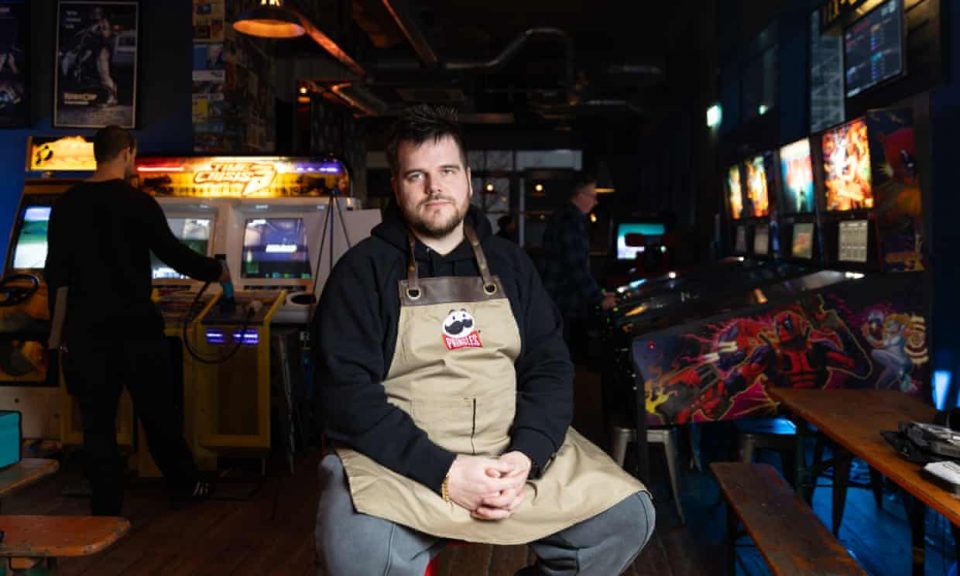N
Amidst an original Donkey Kong arcade machine, a pristine OutRun racing simulator, and booths equipped with GameCubes and Nintendo 64s, engineer Luke Malpass diligently works on repairing a broken Nintendo Wii.
At Four Quarters, a retro arcade located in Elephant and Castle, a steady influx of visitors has brought their old gaming consoles for repairs or upgrades, all offered free of charge, during the arcade’s two-day transformation into a gaming repair clinic.
Gabriella Rosenau, 35, has brought in her malfunctioning Wii, which has languished in her garage for “years”. “I still enjoy playing my brother’s vintage Nintendo 64, and I adore it, but I’m eager to have [the Wii] restored,” she shares.
“I’ve dabbled in Call of Duty and some PlayStation games, but my primary interest lies in retro gaming,” she adds.
Rosenau is part of an expanding community of gamers who are moving away from modern gaming experiences to revisit consoles from their childhood or even earlier eras. In fact, research from Pringles shows that 24% of Gen Z gamers own a retro console.
What began as a personal passion for Malpass—reviving old consoles—quickly flourished into a full-time enterprise. At the height of the pandemic, his company RetroSix expanded to employ 16 individuals to meet demand. He attributes this surge to the combination of people being homebound and rediscovering long-forgotten gadgets. “People were bored, uncovering items at home and searching for retro games online.”
“We started off selling exclusively on eBay; we didn’t even have our own website. For a while, eBay restricted our sales, suspecting fraudulent activity,” he recalls. “It completely took over our lives.”
RetroSix continues to receive hundreds of repair requests each month from individuals wishing to restore or upgrade their consoles. Although this interest has “stabilized,” according to Malpass, the community remains on the rise.
“The demographic has broadened. There are older enthusiasts in their late 40s and early 50s, often coming from a PC gaming background with Amigas and Commodores. Then there are those in their 30s, nostalgic for Game Boys, Mega Drives, Super Nintendo Entertainment Systems, and the like.
“Finally, there’s a younger crowd, either nostalgic for the Nintendo DS era, which is transitioning to retro, or those captivated by retro gaming in general. Some twenty-somethings are even more passionate than we are, despite not growing up with it,” he explains.
Malpass has cultivated a substantial following on social media, garnering 61,700 subscribers on his YouTube channel, AngelSix, and 44,100 followers on the TikTok account for RetroSix. He shares repair tips and showcases his creations with the community.
Young gamers engaging online express a draw toward retro titles due to their unique gameplay and the opportunity to “disconnect,” says Malpass.
“With older consoles, you simply power on and begin gaming—there’s no stress, no internet, and no worldwide competition. You immerse yourself in the game, achieving a sense of accomplishment. That was the original appeal,” he notes.
“For younger gamers, the pressures they face in today’s social media-driven environment can be incredibly taxing. [Retro gaming] serves as their safe space, an escape,” he adds.
Matthew Dolan, a software developer in his 40s, arrived with components from his Game Gear console. His deep-rooted passion for retro gaming originates from nostalgic moments spent playing games his father developed for him on the BBC Micro. “It introduced me to technology in an engaging way,” he explains.
“The joy of playing those games is unparalleled. I remember planning long car trips around battery life,” he reminisces. “These retro experiences aren’t reliant on flashy graphics like many modern games.”
Taking his interest further, Dolan now repairs and modifies gaming consoles himself, estimating he spent £7,000 on his hobby last year. “I recouped some costs by reselling items, but it’s an expensive pursuit.”
He encountered difficulties while trying to fix certain chips on his Game Gear and sought Malpass’s expertise. For a restored Prestige Edition Game Gear from RetroSix, the cost is £298.80, while the LED version is priced at £334.80, and repair services begin at £36.
Game Boy
The Game Boy, developed and produced by Nintendo, was released in Japan in 1989 and reached Europe in 1990. It is estimated that over 118.7 million units of Game Boy and Game Boy Color have been sold globally, making it one of the most successful handheld gaming consoles of its time due to its compact size and affordability.
SNES
Known as the Super Nintendo Entertainment System or Super NES, this console was Nintendo’s second home video game console released internationally. It debuted in Japan in 1990 and became available in Europe in 1992. By the time it was phased out in 2003, it had sold approximately 49.1 million units worldwide.
Original Xbox
The original Xbox, Microsoft’s inaugural entry into the gaming console market, was first launched in Europe in 2002. Priced at £299, it competed against the Sony PlayStation 2 and Nintendo GameCube. The Xbox 360, its successor, was launched in 2005.
Amiga
Produced by Commodore International from 1985 until their bankruptcy in 1994, the Amiga series of personal computers included the Amiga 1000, known for its advanced graphics and sound capabilities. Popular games from this era include Alien Breed, Syndicate, Sensible Soccer, and Eye of the Beholder.
Game Gear
Released by Sega first in Japan in 1990 and later in Europe, the Game Gear was a handheld gaming console competing against the Nintendo Game Boy, Atari Lynx, and NEC’s TurboExpress. In 1991 alone, around 520,000 Game Gear units were sold in Europe, with UK sales exceeding 130,000 units.


